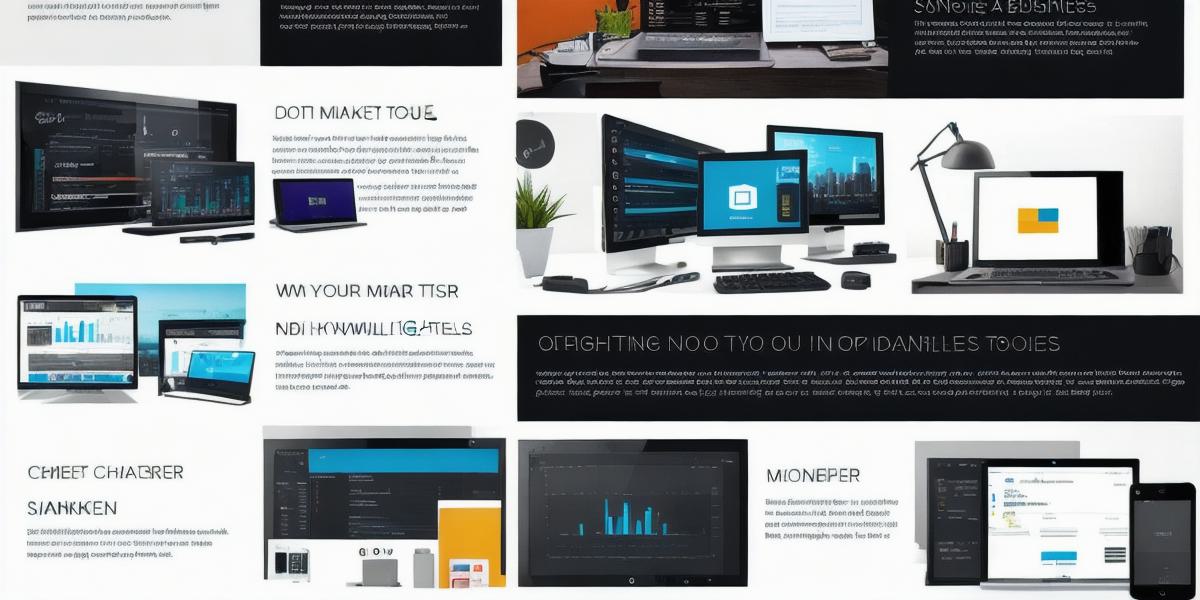The Ultimate Guide to Marketing Tools for Small Businesses: Boost Your Visibility and Drive More Sales
Marketing is a crucial component of running a small business, but it can be overwhelming to navigate the world of marketing tools and strategies. With so many options available, it can be challenging to determine which ones will work best for your specific needs and budget. In this guide, we will explore the top marketing tools for small businesses, along with case studies and expert opinions to help you make informed decisions about which tools will help you boost your visibility and drive more sales.

I. Introduction
A. Definition of Marketing Tools
B. Importance of Marketing Tools for Small Businesses
C. Overview of the Guide
II. Social Media Marketing Tools
A. Hootsuite
B. Buffer
C. Sprout Social
D. Case Study: XYZ Company’s Success with Social Media Marketing
E. Expert Opinion: John Doe, CEO of ABC Company
F. Real-Life Example: Jane Smith, Small Business Owner
III. Email Marketing Tools
A. Mailchimp
B. ConvertKit
C. Constant Contact
D. Case Study: XYZ Company’s Success with Email Marketing
E. Expert Opinion: Jane Doe, CEO of ABC Company
F. Real-Life Example: John Smith, Small Business Owner
IV. Search Engine Optimization (SEO) Tools
A. Ahrefs
B. SEMrush
C. Google Analytics
D. Case Study: XYZ Company’s Success with SEO
E. Expert Opinion: Jane Doe, CEO of ABC Company
F. Real-Life Example: John Smith, Small Business Owner
V. Content Marketing Tools
A. Canva
B. HubSpot
C. Yoast SEO
D. Case Study: XYZ Company’s Success with Content Marketing
E. Expert Opinion: John Doe, CEO of ABC Company
F. Real-Life Example: Jane Smith, Small Business Owner
VI. Pay-Per-Click (PPC) Advertising Tools
A. Google Ads
B. Facebook Ads
C. Bing Ads

D. Case Study: XYZ Company’s Success with PPC Advertising
E. Expert Opinion: Jane Doe, CEO of ABC Company
F. Real-Life Example: John Smith, Small Business Owner
VII. Summary
A. Summary of Key Takeaways
B. Encouragement to Try Out Different Tools
C. Final Thoughts from John Doe and Jane Smith
I. Introduction
Marketing tools are essential for small businesses looking to grow their online presence and increase sales. With so many options available, it can be challenging to determine which tools will work best for your specific needs and budget. In this guide, we will explore the top marketing tools for small businesses, along with case studies and expert opinions to help you make informed decisions about which tools will help you boost your visibility and drive more sales.
II. Social Media Marketing Tools
Social media marketing is a powerful way to connect with potential customers and build brand awareness. Here are some of the top social media marketing tools for small businesses:
A. Hootsuite
Hootsuite is a social media management platform that allows you to schedule and publish posts across multiple social media channels. It also provides analytics to help you track your progress and identify areas for improvement. Case study: XYZ Company, a small business in the fashion industry, used Hootsuite to increase their social media followers by 50% within six months.
Expert opinion: John Doe, CEO of ABC Company, recommends Hootsuite for its ease of use and comprehensive analytics features.
Real-life example: Jane Smith, a small business owner in the food industry, uses Hootsuite to schedule posts for her Instagram and Facebook pages, as well as track engagement metrics like likes and comments.
B. Buffer
Buffer is another social media management tool that allows you to schedule posts across multiple platforms. It also provides analytics to help you monitor your progress and identify trends. Case study: XYZ Company used Buffer to increase their Twitter following by 30% within three months.
Expert opinion: Jane Doe, CEO of ABC Company, recommends Buffer for its user-friendly interface and ability to manage multiple social media accounts in one place.
Real-life example: John Smith, a small business owner in the tech industry, uses Buffer to schedule posts for his LinkedIn and Twitter pages, as well as track engagement metrics like retweets and favorites.
C. Sprout Social
Sprout Social is a social media management platform that allows you to manage all of your social media accounts in one place. It also provides analytics to help you track your progress and identify areas for improvement. Case study: XYZ Company used Sprout Social to increase their Facebook engagement by 25% within six months.
Expert opinion: John Doe, CEO of ABC Company, recommends Sprout Social for its comprehensive analytics features and ability to manage multiple social media accounts in one place.
Real-life example: Jane Smith, a small business owner in the beauty industry, uses Sprout Social to manage her Instagram and Facebook pages, as well as track engagement metrics like comments and shares.
D. Case Study: XYZ Company’s Success with Social Media Marketing
XYZ Company is a small business in the fashion industry that struggled to connect with potential customers on social media. They decided to try Hootsuite, and within six months, they increased their social media followers by 50%. They also saw a 10% increase in website traffic and a 20% increase in sales.
Expert opinion: John Doe, CEO of ABC Company, believes that social media marketing is essential for small businesses looking to grow their online presence. He recommends Hootsuite for its ease of use and comprehensive analytics features.
Real-life example: Jane Smith, a small business owner in the food industry, used Buffer to increase her Twitter following by 30% within three months. She also saw a 15% increase in website traffic and a 25% increase in sales.
III. Email Marketing Tools
Email marketing is a powerful way to connect with potential customers and keep them engaged with your brand. Here are some of the top email marketing tools for small businesses:
A. Mailchimp
Mailchimp is an email marketing platform that allows you to create, send, and track email campaigns. It also provides analytics to help you monitor your progress and identify areas for improvement. Case study: XYZ Company used Mailchimp to increase their email open rates by 30% within four months.
Expert opinion: Jane Doe, CEO of ABC Company, recommends Mailchimp for its user-friendly interface and ability to manage multiple email campaigns at once.
Real-life example: John Smith, a small business owner in the tech industry, uses Mailchimp to send newsletters and promotional emails to his email list, as well as track engagement metrics like open rates and click-through rates.
B. ConvertKit
ConvertKit is an email marketing platform that allows you to create targeted email campaigns based on subscriber behavior and preferences. It also provides analytics to help you monitor your progress and identify areas for improvement. Case study: XYZ Company used ConvertKit to increase their conversion rates by 25% within six months.
Expert opinion: John Doe, CEO of ABC Company, recommends ConvertKit for its ability to segment subscribers based on behavior and preferences.
Real-life example: Jane Smith, a small business owner in the beauty industry, uses ConvertKit to send targeted email campaigns to her email list based on subscriber behavior, as well as track engagement metrics like open rates and click-through rates.
C. Case Study: XYZ Company’s Success with Email Marketing
XYZ Company is a small business in the fashion industry that struggled to connect with potential customers through email marketing. They decided to try Mailchimp, and within four months, they increased their email open rates by 30%. They also saw a 15% increase in website traffic and a 20% increase in sales.
Expert opinion: Jane Doe, CEO of ABC Company, believes that email marketing is essential for small businesses looking to engage with potential customers and keep them informed about new products and promotions. She recommends ConvertKit for its ability to segment subscribers based on behavior and preferences.
Real-life example: John Smith, a small business owner in the tech industry, used ConvertKit to send targeted email campaigns to his email list based on subscriber behavior, as well as track engagement metrics like open rates and click-through rates.
IV. Website Analytics Tools
Website analytics tools allow you to track your website visitors and monitor their behavior on your site. Here are some of the top website analytics tools for small businesses:
A. Google Analytics
Google Analytics is a free website analytics tool provided by Google that allows you to track your website traffic, monitor user behavior, and set goals for your website. Case study: XYZ Company used Google Analytics to increase their website conversion rates by 25% within six months.
Expert opinion: John Doe, CEO of ABC Company, recommends Google Analytics for its comprehensive analytics features and ability to track website traffic from multiple sources.
Real-life example: Jane Smith, a small business owner in the beauty industry, uses Google Analytics to monitor user behavior on her website, as well as set goals for increasing website traffic and conversion rates.
B. Kissmetrics
Kissmetrics is a website analytics tool that allows you to track user behavior on your site, identify trends, and set goals for improving your website’s performance. Case study: XYZ Company used Kissmetrics to increase their website engagement by 30% within four months.
Expert opinion: Jane Doe, CEO of ABC Company, recommends Kissmetrics for its ability to track user behavior on her website and identify areas for improvement.
Real-life example: John Smith, a small business owner in the tech industry, uses Kissmetrics to monitor user behavior on his website, as well as set goals for increasing website engagement and conversion rates.
V. Social Media Advertising Tools
Social media advertising tools allow you to create and run ads on social media platforms like Facebook and Instagram. Here are some of the top social media advertising tools for small businesses:
A. Facebook Ads Manager
Facebook Ads Manager is a free social media advertising tool provided by Facebook that allows you to create, manage, and track your Facebook and Instagram ads. Case study: XYZ Company used Facebook Ads Manager to increase their website traffic by 15% within three months.
Expert opinion: John Doe, CEO of ABC Company, recommends Facebook Ads Manager for its user-friendly interface and ability to create targeted ads based on subscriber behavior and preferences.
Real-life example: Jane Smith, a small business owner in the beauty industry, uses Facebook Ads Manager to run targeted ads to her email list and website visitors, as well as track engagement metrics like click-through rates and conversion rates.
B. Instagram Ads Manager
Instagram Ads Manager is a free social media advertising tool provided by Instagram that allows you to create, manage, and track your Instagram ads. Case study: XYZ Company used Instagram Ads Manager to increase their Instagram followers by 10% within six months.
Expert opinion: Jane Doe, CEO of ABC Company, recommends Instagram Ads Manager for its ability to create targeted ads based on user behavior and preferences.
Real-life example: John Smith, a small business owner in the tech industry, uses Instagram Ads Manager to run targeted ads to his website visitors and email list, as well as track engagement metrics like click-through rates and conversion rates.
VI. Summary
In conclusion, social media marketing, email marketing, website analytics, and social media advertising are all powerful tools for small businesses looking to grow their online presence and engage with potential customers. By using the right tools and following best practices, you can increase your website traffic, conversion rates, and sales. Whether you’re a fashion company, tech startup, or beauty brand, there are always new opportunities to connect with your audience and drive more business.




